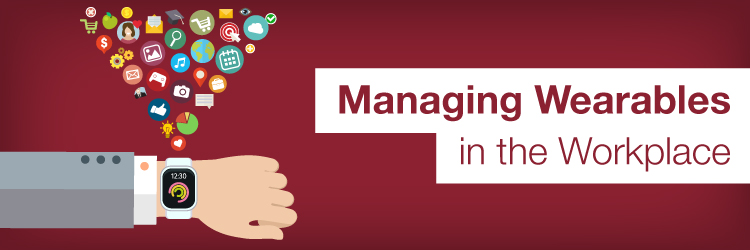
Wearable technology devices are growing increasingly popular. Sixty-four percent of internet users ages 16 to 64 have used wearable technology or plan on doing so in the future, according to GlobalWebIndex. Wearables include smartwatches, activity trackers, lifeloggers and medical sensors, Consumer Reports says.
People are not only tapping into the benefits of wearable technology for personal use; they also use wearables in the workplace. As a result, employers have the responsibility of managing wearable technology at work. IT professionals must be prepared to solve problems related to wearables in the workplace, particularly security and privacy threats.
Use of Wearables in the Workplace
The benefit of wearables in the workplace revolves around the data employers can collect about their employees. This information has the potential to improve efficiency and cut costs. Here are three ways wearables are being applied in the workplace.
Cutting Healthcare Costs
The most common use of wearables in the workplace involves the use of personal activity trackers to improve the health of employees and cut healthcare costs. Most employers spend a large portion of employee benefit expenses on health insurance. By utilizing the wearables that so many employees already have, employers can encourage the adoption of healthy lifestyle habits as part of wellness campaigns. Employers can then show their employees are healthier, leading to reductions in the cost of health insurance premiums. According to the National Business Group on Health, 37 percent of large employers used activity trackers for healthcare purposes in 2015 with another 37 percent planning to adopt the technology in coming years.
Monitoring Physical Labor
Workers in factories, warehouses and other environments with physical labor are starting to see wearable devices become a part of the job. Wearable technology can improve safety, productivity and efficiency by tracking the movement and positioning of employees. If analysis pinpoints safety risks, employers can address them. Wearables that track important information such as heart rate, blood pressure and hydration can play a role in preventing health incidents.
Accessing Information on Smaller Devices
Wearables offer easy methods for quickly calling up work-related information. The Apple Watch and other smartwatches give users the ability to access email, make calls, check schedules and perform several other tasks without taking out a phone. As a result, some companies are buying smartwatches for their employees.
Challenges and Concerns
While the benefits of wearables in the workplace are numerous, there are plenty of concerns centering on privacy and security.
Security
When companies gain access to personal data about employees, securing the data must become paramount. Companies participating in wellness programs must keep personal health information private or risk legal action. According to Symantec, only 52 percent of wearables have a privacy policy, and many developers have failed to limit the public visibility of user information.
Promotions and Firings
One legitimate qualm some employees have about wearables in the office is how they could contribute to their performance review. Is information gained from wearables being used to justify raises, promotions or firings? If so, that would be a legal issue. Employers cannot discriminate against “less healthy” employees or those with a disability.
This is especially an issue for those performing physical labor. If a wearable reflects poor performance, an employer has to take into account any injury or physical disability that could be present.
Spying
With wearables, spying becomes a possibility. Employers should outline when and where all audio, video and location data from wearables will be recorded. They should ensure employees only use devices during work hours. For example, factory workers don’t need to document their location outside of work, so leaving devices at work is best. This prevents data from being accidentally recorded and helps free employers of any potential legal problems.
How IT Professionals Can Manage Wearables
Here are three important tips to keep in mind when managing wearable technology for your employer.
Don’t Underestimate Your Data
When you’re dealing with wearables, information at your fingertips could put both employees and your employer at risk. Activity trackers contain information that is valuable to criminals, competitors and a host of other groups. Improperly handling security could lead to thieves compromising your entire system and gaining sensitive data about employees and customers.
Choose Substance Over Style
Wearables are essentially accessories. This has led some manufacturers to sacrifice security for usability. As an IT professional, you have to value security first. While many wearables were not designed for business use, there are more and more options available that have businesses in mind. These products have more robust security features.
Silo Personal Data
Mobile devices, especially wearables, allow data to move easily, so their operating systems are leaky by design. This doesn’t bode well for companies that are trying to prevent security problems. By keeping wearable data in encrypted containers, you can control where data lives. For example, limit what emails are sent to smartwatches. This forces employees to use more secure means of communication and helps lower security risk.
Understanding Wearables in the Workplace
Mobile devices, including wearable technology, are an important aspect of IT management. Campbellsville University’s online IT MBA program prepares students to become effective IT managers through courses in security, emerging technology and more. The fully online program allows students to maintain their personal and work responsibilities while pursuing their career goals.
